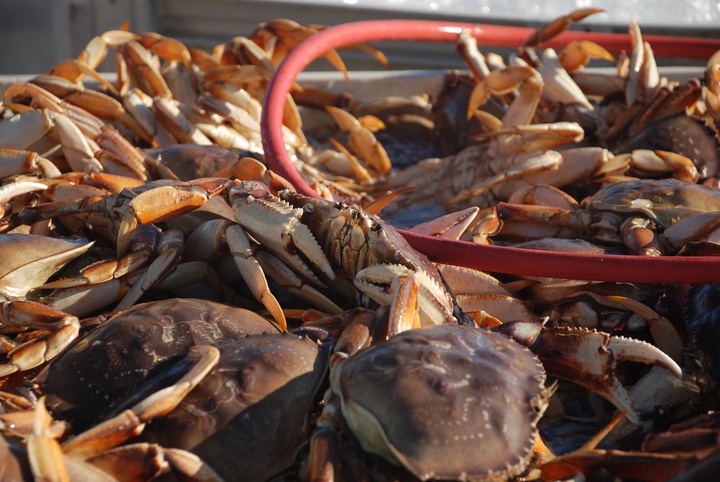Jessica Cejnar Andrews / Tuesday, Feb. 22, 2022 @ 4:57 p.m. / Emergencies, Local Government
Del Norte Supervisors Call Plan to Incorporate Cultural, Natural Resource Preservation into Emergency Preparedness 'No Brainer'

Kymmie Scott used Del Norte County's commercial Dungeness crab fleet as an example of a natural resource worth protecting and preserving during a disaster. File photo by Jessica C. Andrews
Kymmie Scott went back in time nearly 58 years when making her case to county supervisors that Del Norte needs a plan and a team to protect its cultural and natural resources during a disaster.
Crescent City had a vibrant downtown before the 1964 Good Friday Earthquake and Tsunami, the county's former emergency services manager told supervisors Tuesday. The tidal wave didn't just deal an economic blow to Del Norte, "it also sort of gutted the soul of the community," she said.
"That was the heart of who Crescent City was," Scott told the Wild Rivers Outpost. "And I feel like, as an outsider coming in, it seems to me the community's been struggling to figure out who it is again following that."
Del Norte County's personal and community identity exists in the resources that are important to its people, Scott said. The communities that bounce bast from a disaster, natural or otherwise, faster are those who place an importance on their cultural resources, she said.
"I think about things like our museum collections, about our regalia collections and the traditional knowledge our indigenous elders hold, our art collections," Scott said. "Our community is really unique in the fact that we have a UNESCO World Heritage Site, we have these wild and scenic rivers, we have four tribes with trust properties within the Del Norte borders — these resources are really really important to this community."
Four Del Norte County supervisors agreed with Scott, approving a professional services agreement with her employer, emergency preparedness and disaster recovery consulting firm, Tidal Basin, to create the Natural and Cultural Resource Protection and Preservation Program, or NCRP3.
District 5 Supervisor Bob Berkowitz was absent.
According to Scott, who was one of 10 participants in the 2021 Leadership for Cultural Heritage Stewards in Challenging Circumstances course, a program through the Smithsonian Cultural Rescue Initiative and the Prince Claus Fund, NCRP3 is the first of its kind for a local government in the United States.
“This is something that hasn’t really been done,” she told supervisors. “We can be the first ones to go out there and establish a framework for how to do this and hopefully be an inspiration to other communities like ours.”
The budget for the project is $100,000, according to Scott. Tidal Basin would offer her time during normal business hours to develop the project — an in-kind donation of about $50,000. The second phase of the project would pay for supplies and equipment as well as training, Scott said. She said she is currently pursuing grant funding to pay for the second phase of the project, which is about a year out.
Scott said she hopes to wrap the NCRP3 project no later than August 2024.
NCRP3 would consist of creating a team of stakeholders and experts representing different facets of the community who would be responsible for cataloging the values in their realm that are at risk, Scott said. That team would consist of members of local tribes as well as the Hmong and Latinx communities.
Representatives of the Del Norte County Historical Society and the Del Norte Association for Cultural Awareness could also be involved, Scott said.
“I talk a little bit about tangible and intangible artifacts,” she said. “Tangible things being art collections and museum collections — stuff that has history — regalia collections. It could be the natural resources our crab fleet lives off of.”
Intangible resources could include the traditional knowledge Del Norte County’s tribal communities have passed down over generations, Scott said.
“Looking at those realms — what do we have here in this community that’s important to the project — is phase one,” she said. “And there are areas that I know are going to be delicate. I would say some village sites for our tribes are well known, but I know there are sites that aren’t well known and people don’t want to be well known because of looting.”
NCRP3 would also train that team on how to get artifacts and other important cultural items to safety during an emergency and how to provide “first aid” to halt any smoke or water damage those resources may sustain during a disaster, Scott said.
This team would provide cultural and heritage “first aid” to halt any water or smoke damage those resources may sustain during a disaster, Scott said. The project would also create standard operating procedures enabling the local community to work with national and international groups to bring in a higher level of assistance if needed, she said.
Scott told supervisors she also needs to work with the Del Norte Office of Emergency Services since once she’s finished creating the program, NCRP3 would be housed within the county.
“Once the plan is created we hope to annex it to the emergency operations plan,” Scott told supervisors, adding that it would go before the county’s director of OES, as well as the sheriff, Crescent City Fire Chief and Crescent City Police Chief. “It would be looked over by folks who know what they’re doing before it gets adopted.”
She said she hopes the Office of Emergency Services would still oversee NCRP3 once she’s finished assembling and training the team.
Supervisors Chris Howard and Valerie Starkey called NCRP3 a “no brainer,” with Howard pointing out the damage caused to Japan by the March 11, 2011 tsunami.
“Everything was lost,” he said. “I’d love to see Del Norte County be an example for the nation on how to preserve and protect what’s very important to our community.”
Documents:
• Professional Services Agreement with Tidal Basin
CLICK TO MANAGE